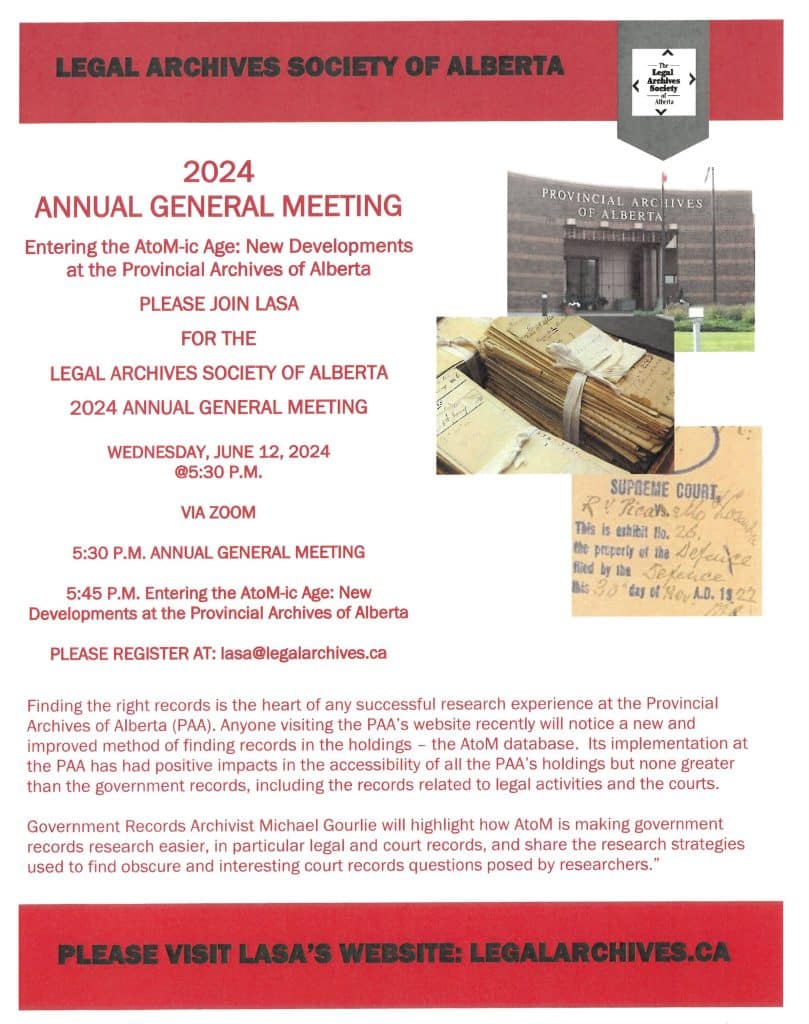
LASA hosted its Annual General Meeting on June 12, 2024, via ZOOM. Members of the current Board of Directors re-appointed for a two-year term are Hon. Madam Justice Jo’Anne Strekaf, Aaron Bickman, K.C., Brian Kiers, and Leslie Stitt. LASA also welcomes Hon. Justice Lloyd Robertson, Tanya Kuehn, K.C., Prabhjot Punnia, and Patricia Sealy, K.C. to the Board of Directors.
LASA was joined by Michael Gourlie, the Government Records Archivist at the Provincial Archives of Alberta (PAA), who spoke about the history of the PAA, AtoM (Access to Memory) database, justice-related records at the PAA, and how to search for interesting court records.
The Provincial Archives of Alberta is located in Edmonton and is the official repository for records created by the government of Alberta. In order to form a balanced historical view of society, they also collect provincially significant private records.
Recently, the PAA obtained a new database known as AtoM (Access to Memory), which allows researchers to search online for descriptions of records at the Provincial Archives. The public can access this database at https://provincialarchives.alberta.ca/.
Mr. Gourlie turned his attention to some of the justice-related records held at the PAA. Currently the archives hold nearly 10 km of records associated with justice, 5 km of which are court records. Records received from the Ministry of Justice and its predecessors from 1963 to 2020 have been described to the series or fonds level in AtoM.
Generally, these records fall into three broad categories. First, the court records are comprised of civil case files (including divorce and probate), criminal case files, and records related to other court activities such as registration and court administration. Second, the government departments, which includes the Crown Prosecutor’s Office, Magistrates and Justices of the Peace, as well as advice and civil litigation matters. Lastly, the PAA holds some early records and files from Alberta lawyers.
Business needs largely dictate when the records or files are transferred to the Provincial Archives. For the most part, the courts retain their records, depending on the content of the file, any where from ten to eighty years. Whereas department files are transferred after two years and up to fifty years. This does not mean that files not yet transferred are inaccessible for research. However, rather than going to the PAA, a researcher will contact the specific Ministry directly.
Court files and records are an invaluable source of information for any researcher. They provide more details than the final judgement or case summary. It is best that researchers come prepared with as much information as possible to assist the archivist in narrowing any research request. Also, understanding restrictions on access is key. Though court records are not subject to FOIP legislation, there may be some court-imposed restrictions or other legislation that may apply. Depending on the period, Ministry records may also be subjected to FOIP restrictions or solicitor-client privilege.
LASA would like to thank all those who attended the Annual General Meeting. Also, a special thanks to Michael Gourlie who gave an interesting presentation on the some of the justice related records and files at the PAA, and how to search them online through their new AtoM database.




